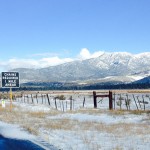2015-16 El Niño may be mighty
By JP Crumrine
News Editor
El Niño conditions or patterns, which have recently become daily conversation on the Hill, are not defined by the amount of precipitation. Rather, the National Weather Service defines them as higher-than-normal sea-surface temperatures along the equator from the coast of South America to the central Pacific Ocean.
When these ocean waters warm up, weather conditions can change from Australia to the Atlantic. The normal winter jet-stream path changes and can bring more precipitation to Southern California west to Texas, and warmer and drier weather to the northern Midwest and East Coast.
The current Pacific Ocean temperatures in this area have been increasing since late spring 2015 and are now higher than ever. NWS forecasts for the persistence of El Niño conditions into fall 2015 began late in the spring. By summer, NWS offered an 80-percent likelihood El Niño would continue into winter. Ocean temperatures continued to rise throughout the fall.
This El Niño pattern appears to be a harbinger of a very wet winter, according to NWS meteorologists. In December, the NWS forecast that El Niño is expected to remain strong through the Northern Hemisphere winter of 2015-16. A transition to a neutral state is anticipated to begin during late spring or early summer 2016. Substantial precipitation in this area from January through late March and perhaps into April also is forecast.
The abundance of rain and snow will be a welcome relief to local vegetation suffering from the fourth year of sustained drought. Nevertheless, NWS does not project sufficient rain to offset the four years of drought.
NWS San Diego meteorologist Alex Tardy has said that more frequent storms are neither necessarily stronger nor warmer.
In November, a Federal Emergency Management Agency report identified several important aspects of a strong El Niño pattern. Not only do more wet days occur, but these days tend to be wetter than a normal rainy winter day. Looking at records from the last strong El Niño, which was in 1997-98, several California communities experienced rain on 25 or more days in both January and February.
“The lack of any significant letup in rains allowed almost no days for drying,” the report’s authors wrote. “Each period of heavy rain sent more earth sliding to lower elevations at a number of locations in the central and south part of the state.”
Locally, the concern for flooding and possible mudslides has been taken seriously. The Mountain Disaster Preparedness group held a community meeting about the possible winter weather as early as Sept. 1 and more than 150 people filled the Idyllwild Library.
In early December, Riverside County officials called another community meeting — at the Idyllwild Nature Center, which attracted nearly 60 people. The message was that the effects from the impending El Niño rainfall will create more responsibilities in the rural parts of Riverside County than for urban residents.
Jared Gibbon of the Riverside County Department of Transportation urged residents, before the storms begin, to be sure their gutters and roofs are clear, roof leaks are fixed, to check for loose roof tiles or shingles, and to store outdoor furniture or other objects that might be damaged or thrown by strong winds.
If channels, road culverts or roadside ditches are clogged during a storm and water is building up, Kathy Henderson of the county’s Emergency Management Department told attendees they could call 951-955-1230 for help.
Sandbags are available at the local water districts and fire district. Fern Valley and Pine Cove water districts also have sand available.
Pine Cove got a new ambulance service
By JP Crumrine
News Editor
In July 2015, emergency medical service for Pine Cove and other portions of the Hill, except Idyllwild, changed substantially.
In January, the Riverside County Board of Supervisors approved a new contract between Riverside County and American Medical Response, shifting the ambulance service for County Service Area 38 (Pine Cove) and from Lake Hemet to Poppet Flats from the Idyllwild Fire Protection District to AMR.
IFPD has an exclusive operating right to provide these services within its jurisdiction, but provision of these services outside of the district will be limited to backing up AMR.
The county’s new contract with AMR was effective July 1 and is for five years, but AMR may earn 10 one-year extensions
However, this change does have a financial effect on IFPD. In fiscal year 2014-15, the last year of the old contract, IFPD received almost $180,000 from Riverside County for being available to transport people from outside the district. In addition, about 20 percent of IFPD’s medical transports were from these areas, which could result in a proportionate reduction in its ambulance fees or about another $60,000.
Pine Cove residents will no longer reimburse the county for ambulance service beyond the cost of the actual call and transport, if necessary. Since the 1990s, Pine Cove residents have paid, through their CSA 38 parcel fees, for the availability of ambulance service from IFPD.
Since the payment to the county is now removed, the CSA 38 Advisory Committee began looking at whether the fee should be terminated or modified. The committee discussed asking CSA 38 residents whether to continue the fee or eliminate it. This might take the form of a public vote in 2016 at either the June primary or the November general election.
In 2004, 76 percent of Pine Cove residents approved $50 per parcel with a 2-percent annual increase. The current rate is $59. Last year, CSA 38 received about $92,000 from this source, which was less than the now-terminated annual contract cost.
The reasons for the change were discussed at the board meeting.“[Former] Supervisor [Jeff] Stone made that commitment and the county will honor the commitment,” said Bruce Barton, director of the Riverside County Emergency Medical Services Agency. “We will not waffle.”
In presenting the proposal to the board, Barton said, “This agreement represents the last step in a two-year planning process that included the public and the multiple EMS stakeholders.”
“We’re very pleased to be in Pine Cove,” said Doug Key, AMR’s general manager in the county. “This is just a different response area, but more coverage on the Hill. By adding the mountain, we improve our service.”
“The challenge of working here is the time of transport to a hospital,” said Jack Hansen, the AMR official who oversees the local service. In addition, he showed his experience when he said AMR has purchased 4-wheel drive ambulances for Pine Cove.
AMR leased a house on Sherman Drive to serve as its station, where the crews sleep and eat. Each crew — a paramedic and an emergency medical technician — has a 48-hour shift. Three crews rotate, giving Pine Cove and the area a 24-7 service.
The primary focus on Pine Cove and its other mountain areas was demonstrated when Hansen said this unit would not leave the Hill to back up any other AMR area. While it may provide back-up service to AMR’s Garner Valley and Anza responsibilities and possibly Idyllwild, its attention is local.
“My goal, our goal as AMR, is to coordinate and to cooperate with the Cal Fire, Idyllwild Fire, the Forest Service and the Sheriff’s Department to provide these citizens the best care,” Hansen said. “I’m vested here in the central county. I want to make the service the best service you can get anywhere.”
Lawsuits filed regarding Mountain Fire damages
By Jack Clark
Legal Correspondent
Within days following the Mountain Fire of July 2013 — which threatened the town of Idyllwild while burning some 27,000 acres, destroying 23 structures and costing an estimated $27 million in damages — a Cal Fire press release stated only that it had been caused by “electrical equipment failure.” Several months later, Cal Fire’s heavily redacted report still did not reveal to the public the cause of the electrical equipment failure or the persons responsible for it.
But in July 2015, Cal Fire filed a lawsuit against the owner of the property, Tarek M. Al-Shawaf, and two of his property caretakers, James and Donna Nowlin, alleging that, through their violation of various California codes, they caused the Mountain Fire, resulting in $8.5 million in damages sustained by Cal Fire alone in suppressing the blaze. Specifically, Cal Fire alleged that the fire began “due to an electrical arc between electrically charged wires in an above-ground junction box on the Shawaf property that caused hot material to escape the junction box and ignite the surrounding vegetation.” Cal Fire charged that the junction box and other electrical equipment had been improperly installed and maintained.
Through counsel, Shawaf and the Nowlins filed a formal answer to Cal Fire’s lawsuit, denying all liability for the fire and asserting that others were responsible. Shawaf did admit that the Nowlins were his employees, but denied he had any knowledge of or responsibility for their actions/inactions in the ongoing maintenance of his property.
In another lawsuit, Lon and Susan Paul, Martin Prevosto, Alisia Fisher, and Dug McKellar MTS&L, Inc., aka McKellar Tree Service and Landscaping Inc. made similar allegations against the same defendants, which the defendants also formally denied. Other individuals filed separate lawsuits against Shawaf and the Nowlins, alleging damages to their properties, but it is not clear that those lawsuits have yet been served on the defendants.
The U.S. Forest Service, which is expected to have expended the lion’s share of the costs of fighting the blaze, apparently has yet to file a lawsuit seeking to recover those taxpayer monies, although it appears that fewer than seven months remain until expiration of the applicable statute of limitations period.
2015, a turbulent year for the Art Alliance
By Marshall Smith
Staff Reporter
The Art Alliance of Idyllwild, regarded as one of the most venerable and prestigious of local nonprofits, had a turbulent start in the first months of 2015.
It held a member’s meeting in January with a board convened the previous autumn. The meeting, run by President Marc Kassouf, was fractious from the beginning, with a number of members raising issues. Kassouf had structured the meeting for the board to give reports, to be followed by break-out sessions at which questions could be raised about the board’s presentation. That did not sit well with some members who wanted answers as the presentation unfolded.
Issues raised included: whether board members were exercising their required statutory “duty of care” in serving; whether financial records were available in a timely manner to members upon request; whether the records were accurate, consistent and complied with the law; and whether an audit would be undertaken by the board upon request by members to address questions surrounding record keeping and financial transparency.
In February, a public session following the monthly board meeting at Kassouf’s place of business, organized to address public and member questions, was poorly attended.
On April 10 and 11, the directors voted to resign en masse, effective April 15, leaving the organization without governance. On April 14, one day before the mass resignation became effective, the board’s attorney, Adrian Adams, agreed to serve as interim administrator. He agreed to set up the mechanism for holding an election for a new board. He also closed access to AAI bank accounts, assets, computers, documents and websites. Said Adams, “I have changed all passwords, retrieved the computer and thumb-drives, and changed the locks on the storage shed. The former board is now completely severed.”
Adams issued a call to all members calling for nominations to fill the 11 vacant seats. In the interval until the new board would be seated, Adams canceled a number of scheduled AAI events given there was no board to oversee them.
By the end of April, there were 11 candidates for 11 seats. Because the election was uncontested, Adams announced that the 11 candidates would be seated at a special election meeting to be held Saturday, May 16.
At the May election meeting, the new board was seated. Prior to seating, Barry Zander announced his resignation stating he believed he would be more effective working to support the board from the outside rather than serve on the board. The board chose Shanna Robb as president, Byron Ely as vice president, Erin O’Neill as membership vice president, Del Marcussen as treasurer and Veda Roubideux as secretary. Other seated members were Gerry High, Darcy Gerdes, Terryann Halloran, Peter Szabadi and Cate.
The new board moved quickly to restore its website, post member information and resume staging AAI events culminating with a highly successful Art Walk and Wine Tasting event on Saturday, Oct. 10. The 18th edition of this signature event was sold out days before it occurred.
Shortly after the event, the board released preliminary financial reports showing nearly $30,000 raised and $21,000 netted. Robb said proceeds would benefit art scholarships for local youth and assistance to organizations providing support to young artists.
In a December 6 press release posted on the AAI website (www.artinidyllwild.org), the board announced AAI would be donating $15,000 toward “keeping art alive” in Idyllwild, the largest amount donated since its nonprofit designation in 2002. Among beneficiaries were the smARTS program at Idyllwild School, the Idyllwild Arts Academy, the Associates of Idyllwild Arts, a scholarship for a graduating Idyllwild Hemet High School student going into an arts career, the local nonprofit Musica and two art workshop programs for Idyllwild teens.
The AAI website already lists many upcoming 2016 events.
Town Hall suffers woes in late 2015
By Marshall Smith
Staff Reporter
Idyllwild’s iconic Town Hall, used as a venue for parcel-tax-funded and Riverside-County-managed recreation, figured prominently in the news in the latter part of 2015.
In October, Dawn Sonnier posted criticism on Facebook of county recreation management, noting that for the first soccer game of the year there were “no uniforms, no refs, no goals and no [county] representation” at the game. Her post elicited a firestorm of negative comments from upset parents and others who wondered why they were paying recreation fees and receiving no support from county management.
Riverside County Regional Part and Open Space Recreation Chief Kyla Brown noted county staff was trying to catch up after a series of personnel changes impacted recreation delivery. Both Brown and new Interim Area Manager Marquese Howard moved quickly to try to get programs back on track, but the bitter taste and dissatisfaction with county management remained for parents of young recreation users.
In November, 3rd District County Supervisor Chuck Washington, noting residents’ dissatisfaction, moved to reconstitute the County Service Area 36 Advisory Council, which had long operated to oversee recreation management and advise the supervisor on the conduct of recreation managers. Recreation managers were required to attend monthly council meetings to report on recreation programs and use of parcel tax dollars that funded an annual recreation budget of nearly $200,000. Washington believed that by reconstituting the council, residents of CSA 36 would be able to to review finances and policies for local recreation and street lights, the subjects for which the council was created to review.
As of December 2015, only four applications had been received for five vacant seats. Opal Hellweg, legislative assistant for Washington, agreed to extend the deadline for receiving applications until Jan. 31, 2016. The Advisory Council is not a policy making organization and acts only in an advisory capacity. But by holding regular meetings, it gives CSA 36 residents an opportunity to see how their tax dollars are being used. As of this writing, applicants include Mark Davis, Kathy Wilson, Ginger Dagnall and Susan Nash.
Also in November, a county inspection revealed the presence of asbestos in Town Hall. Consequently, the county closed the venue until such time as a subsequent inspection revealed the scope of asbestos threat and a plan for remediation could be fashioned. Management relocated all programs to the county-managed Nature Center on Highway 243 and arranged transportation though the Hemet Unified School District.
A further inspection revealed the asbestos problem to be minor and manageable. Scott Bangle, Riverside County Regional Park and Open-Space District general manager, said in December that the county would begin repair as quickly as possible “with the goal of returning recreation programs to Town Hall by January [2016], if not sooner.”
Verne Lauritzen, Washington’s chief of staff, recommended the county pay for the repair — isolating the asbestos by creating a false ceiling.
William T. Cloake IV, superintendent of community parks and recreation centers, also wrote to Town Hall Afterschool Program participants that the county would soon undertake the repairs with the goal of resuming recreation on or before Jan. 1, 2016.
Repairs began mid-December. Tuesday, Brown emailed saying repairs were wrapping up and would finish on Wednesday, Dec. 30. “We plan on moving programs back in as of Saturday, Jan. 2,” said Brown. “At this time there are no planned scheduling changes. All programs should resume at Town Hall.”










